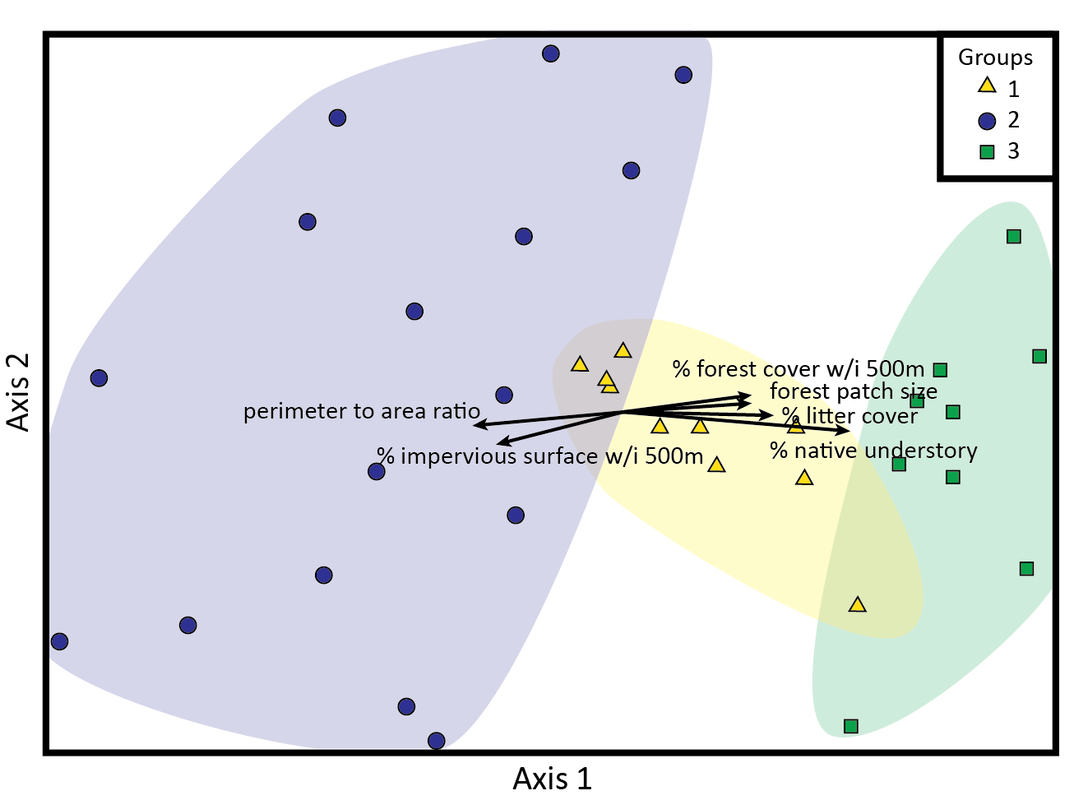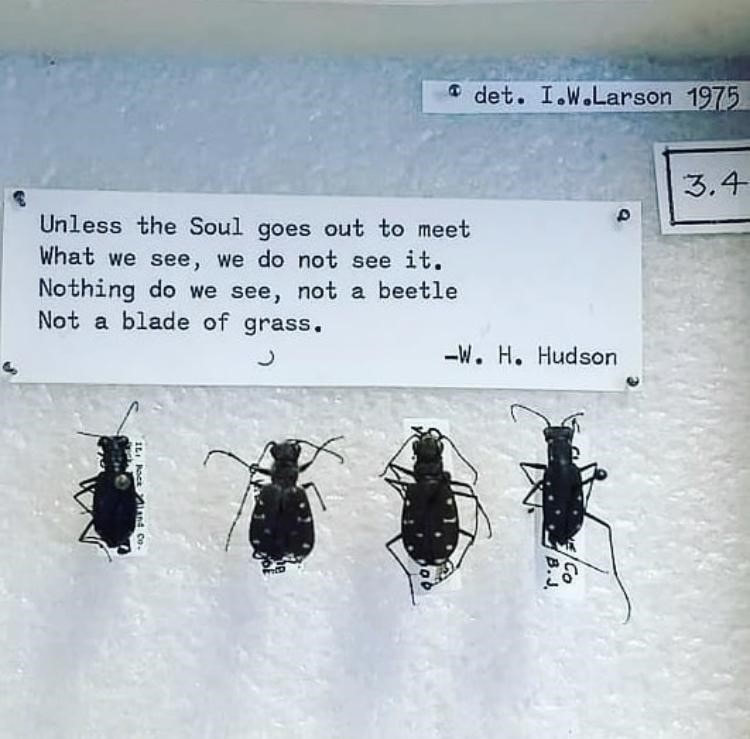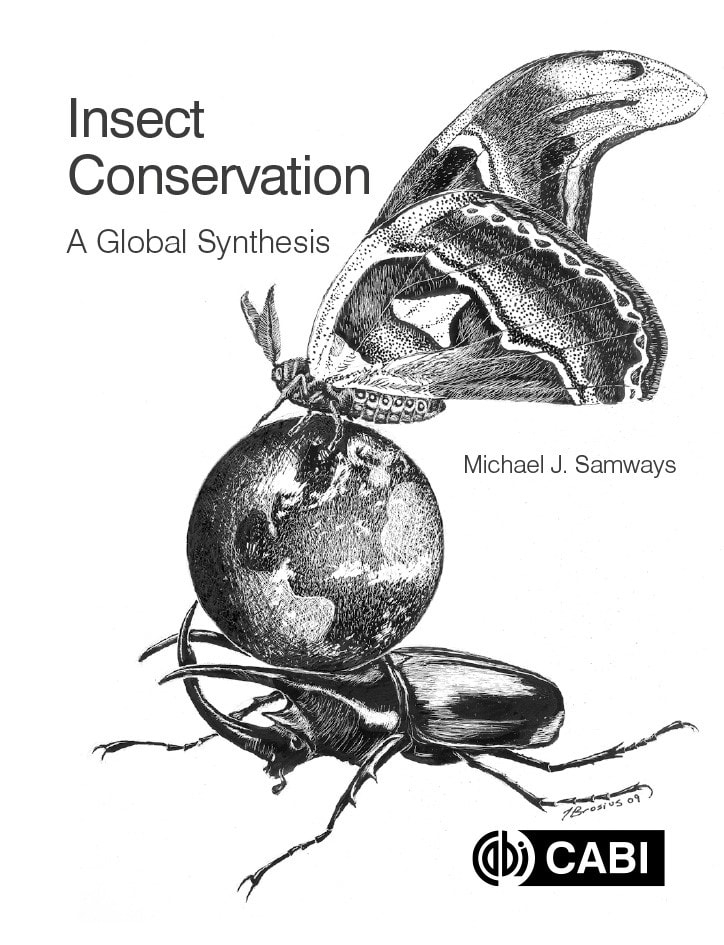Dr. Tierney Brosius completed both her Master's and Ph.D degrees at University of Nebraska – Lincoln. During her graduate years, she studied ecological interactions and conservation biology of tiger beetles, discovering her love of beetles and the diverse ecosystems they inhabit. For the past five years, Dr. Brosius worked with scientists to look at drivers of the ecosystems along the Mississippi River. This region previously had frequent fires and mainly oak trees. As humans began to suppress those fires, Dr. Brosius found there was a turnover of tree species. As an entomologist, she decided to focus on carabid beetles in this area to understand how mesophication interacts with forest community composition. Dr. Brosius measured the diversity of carabid beetles at eighteen forest study sites and found the diversity and composition of an underlying layer of vegetation (understory) drive the assemblages of carabid beetles (Figure 2), and the detailed results will be published soon [1]. In addition to Dr. Brosius’s beetle ecology research, she has also written about cultural entomology, promoting conservation through visual arts, and intersecting insects and art to engage the public in entomology, zoology, and other science fields. As a part of her Ph.D dissertation, Dr. Brosius organized an art exhibit featuring salt creek tiger beetle art. She surveyed attendees before and after the exhibit to measure change in perspective of the salt creek tiger beetle and wrote up her findings which were published in American Entomologist in 2014. She found surveyed individuals were overall positively affected by the exhibit and the most considerable changes in perspective were seen in adult non-academics with statements on knowledge of endangered habitats in Nebraska and knowledge of the salt creek tiger beetle and their saline wetland habitat [3]. At Dr. Brosius’s current position at Augustana College, she has a 100% teaching appointment, leading undergraduate classes like entomology and introductory biology. In the classroom, she incorporates scientific illustration activities to encourage students to slow down and take time to notice details of certain plants and animals; activities like grid guided drawing. She emphasizes to her students that their drawings do not have to be perfect. These gained observational skills allow students to better observe the environment around them, prompting students to ask questions about particular ecosystems. A recent addition to the scope of her work is the curation of the teaching collection at Augustana, making it “more usable and accessible,” Brosius says. This new endeavor has connected her and her students to a wider community of entomologists and naturalists and allows them to tap into their local area’s history and the entomologists who came before them. Brosius’ initial efforts are focused on digitizing and databasing the beetle collection using the Symbiota Collections of Arthropods Network (SCAN). They are starting with Coccinellidae (ladybeetle Family); a vibrant, charismatic taxon that is relatively easy for beginner taxonomists to learn. Another colorful feature of their unique regional collection, and one of Dr. Brosius’ favorites, is the assortment of quotes and poetry tucked in among the specimens (figure 3). As she and her students modernize the collection, she plans to keep the poetry as another avenue for integrating creativity and science into a broad student experience. Dr. Brosius is an artist herself, having created the cover and many of the scientific illustrations for Dr. Michael J. Samway’s textbook, “Insect Conservation: A Global Synthesis” (figure 4) and logos for the Entomological Society of America. She is also the education director of The Guild of Natural Science Illustrators. Dr. Brosius is known as Dr. Beetle on social media posting photos of her illustrations, linocut prints, knitting projects, and embroidery. She also models her many pieces of entofashion, both handmade and purchased pieces. Dr. Brosius uses her platform and art to highlight and communicate information about lesser-known arthropods. She even created her own #entofashion challenge to see how many days she could go, wearing a different piece of entofashion each day. This challenge received media attention, allowing Dr. Brosius to speak to broad audiences about cultural entomology and how her clothing, a form of visual art, draws attention to insects and their importance in our ecosystems. Clearly, Dr. Brosius is a busy person involved in many overlapping and intersecting endeavors. In a discussion with University of Maryland Entomology graduate students, she mentioned that friends and colleagues often ask how she has time to fit in everything she cares about. Her short answer was that she doesn’t. Like most of us, Brosius has commitments outside her academic and professional life: children, family, everyday life. “Perhaps creative outlets connected to my career help me accomplish something that feels like a balance,” she says, but that often there isn’t time for everything. Over her career, she has learned to be okay with that and to recognize the “beauty of ‘no’.” She reminded students that she is in a different place now than when she was a student, able to delegate some things - like housework - and make others, like personal knitting projects and hand work, portable so she can work on them between other responsibilities.
Dr. Brosius encourages entomologists, especially students, to find ways to blend their interests and be open to opportunities that arise from the overlap. It is in these places that we are most able to rejoice in insects. To quote Brosius and Lewis Carroll’s Gnat: “What sort of insects do you rejoice in where you come from?” References: [1] T. Brosius and M. Reisner, "Understory diversity and composition drives carabid assemblages," Biology: Faculty Scholarship & Creative Works, 2015. [2] T. Brosius, L. G. Higley, and L. Johnson, “Promoting the conservation of the salt creek tiger beetle using the visual arts,” American Entomologist, Jan. 2014. [3] T. Brosius, L. G. Higley, and L. Johnson, “Promoting the conservation of the salt creek tiger beetle using the visual arts,” American Entomologist, Jan. 2014. Authors: Huiyu Sheng is a PhD student in the St. Leger Lab studying the phenotypic and genomic differences of several Metarhizium robertsii strains regarding their plant promotion ability and insect-pathogenicity. Kristin Jayd is a Master’s student in the Burghardt lab exploring the ways tree diversity influences parasitoids and their lepidopterous hosts; she is also curating a collection of 100 year old microhymenoptera. Madeline Potter is a Master’s student in the Shrewsbury Lab researching the biology and ecology of Anastatus reduvii, a North American native parasitoid to control Halyomorpha halys. Comments are closed.
|
Categories
All
Archives
June 2024
|
Department of Entomology
University of Maryland
4112 Plant Sciences Building
College Park, MD 20742-4454
USA
Telephone: 301.405.3911
Fax: 301.314.9290
University of Maryland
4112 Plant Sciences Building
College Park, MD 20742-4454
USA
Telephone: 301.405.3911
Fax: 301.314.9290





 RSS Feed
RSS Feed




